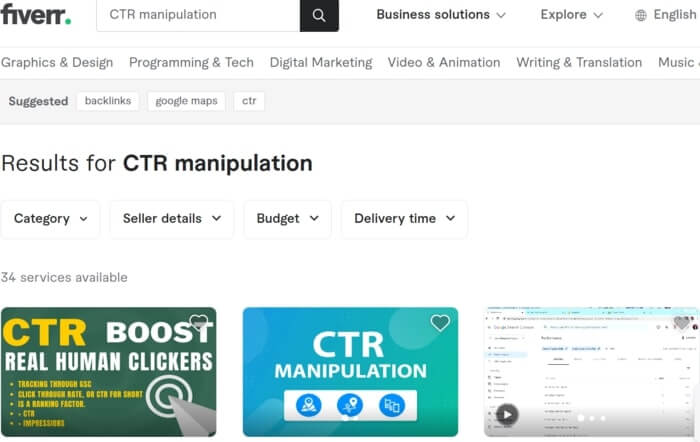How to Determine the Effect of CTR Manipulation on Your Marketing
Understanding the subtleties of click-through price (CTR) manipulation in advertising and marketing is essential for organizations making every effort for authentic customer involvement. By taking a look at crucial metrics such as conversion rates and bounce prices, online marketers can uncover potential disparities that might develop from synthetic enhancements. Using devices like Google Analytics and applying A/B testing can offer understandings right into the performance of different approaches. The ramifications extend past immediate information; the lasting impacts on brand honesty and customer depend on warrant careful factor to consider. What remains to be discovered is exactly how these elements adjoin and affect general advertising success.
Recognizing CTR Control
Recognizing CTR manipulation is necessary for marketers looking for to enhance their projects and make certain information stability. Click-through rate (CTR) refers to the ratio of users that click on a specific web link to the complete number of individuals who see the promotion or content.
The implications of CTR adjustment expand past mere information distortion; they can threaten trust fund in electronic advertising and marketing. When services depend on filled with air metrics, they might purchase ineffective projects, eventually harming their roi. In addition, systems may penalize advertisers involving in such practices, bring about further ramifications for their advertising efforts.
To properly battle CTR adjustment, online marketers should establish an extensive understanding of their data resources and analytics tools. By employing innovative tracking techniques and inspecting traffic resources, they can identify irregular patterns and make sure that their efficiency metrics show real individual involvement - CTR Manipulation Press Release. This watchfulness is essential for cultivating long-term success in a significantly competitive electronic landscape
Trick Metrics to Evaluate
Effective evaluation of vital metrics is important for assessing truth performance of marketing projects and detecting possible CTR control. One primary statistics to consider is the Click-Through Price (CTR) itself, which stands for the ratio of users that click on an ad to the total variety of individuals that view it. An abrupt spike in CTR might show manipulation, demanding more examination.
Additionally, keeping track of conversion prices is vital. A high CTR with a reduced conversion rate might signify that the clicks are not genuine or that the targeting is misaligned (CTR Manipulation). Evaluating bounce rates can offer insight into user engagement; a high bounce rate after a click may suggest that the traffic is not quality-driven.

Tools for Measurement

Additionally, A/B screening tools such as Optimizely or VWO can help with trial and error with different advertisement versions to determine which components drive higher CTR. These tools enable online marketers to analyze real-time efficiency and make data-driven modifications. Social media analytics tools, like Hootsuite or Sprout Social, can also contribute in comprehending CTR within social systems, giving insights into audience behavior and engagement trends.
Furthermore, heat mapping tools, such as Hotjar, can expose how users interact with ads, helping to identify where enhancements can be made. Combining these tools produces a robust dimension structure, making it possible for marketing professionals to determine the effects of CTR manipulation properly. Inevitably, the ideal option of dimension devices is essential for making educated marketing choices and optimizing campaign performance.

Evaluating Long-term Impacts
One have to consider the long-term effects of CTR manipulation on general advertising efficiency, as temporary gains can commonly mask much deeper implications. In time, synthetically blew up click-through rates may result in decreased count on from consumers and online search engine alike. When customers consistently experience deceptive practices, they may come to be reluctant to engage with the brand, leading to lower conversion rates in the future.
In addition, formula updates from systems such as Google are created to prioritize genuine involvement over filled with air metrics. As a result, services that count on CTR manipulation might locate themselves punished, leading to a decline in organic reach and visibility. This can have a cascading impact on brand name trustworthiness and customer loyalty, inevitably weakening the very objectives that the preliminary manipulation looked for to accomplish.
Additionally, the information gathered from manipulated CTR might misguide marketers in their strategy growth. Depending on skewed data can result in illinformed projects that stop working to reverberate with the target audience, leading to lost sources and missed chances. It is critical for marketing experts to assess the long-lasting implications of CTR manipulation and prioritize lasting, moral interaction methods for lasting success.
Ethical Considerations in CTR Adjustment
In the realm of electronic advertising and marketing, moral considerations surrounding CTR manipulation are critical. While the desire to improve click-through rates (CTR) can lead to short-term gains, the potential long-term effects on brand name integrity and consumer trust can not be neglected.
Furthermore, ethical concerns include conformity with laws such as the Federal Profession Payment (FTC) standards, which mandate transparency in advertising. Failing to stick to these criteria can reveal services to legal ramifications and harm their track record. Marketing experts have to think about the implications of their approaches on individual experience and the broader sector landscape.
In addition, the surge of expert system and automation in advertising presents more moral problems. The potential for mathematical predisposition or the exploitation of consumer information questions about liability and justness. Ultimately, honest marketing techniques ought to focus on transparency, sincerity, and respect for the customer, fostering long-lasting relationships that transcend plain metrics like CTR. Balancing performance with ethics is necessary for sustainable success in the electronic marketplace.
Conclusion
In final thought, measuring the influence of CTR control on advertising requires a detailed analysis of vital metrics, consisting of click-through prices, conversion rates, and bounce rates. Ultimately, a data-driven technique makes certain that advertising LinkDaddy CTR Manipulation and marketing methods are effective and lined up with real individual interactions.
Recognizing the nuances of click-through price (CTR) adjustment in marketing is important for businesses aiming for genuine customer engagement.Reliable analysis of vital metrics is important for evaluating the real performance of advertising campaigns and finding prospective CTR manipulation.One need to think about the lasting results of CTR control on total advertising efficiency, as short-term gains can commonly mask deeper ramifications.In the world of digital advertising and marketing, honest factors to consider surrounding CTR control are extremely important.In conclusion, determining the influence of CTR manipulation on advertising and marketing requires a detailed evaluation of key metrics, including click-through prices, conversion prices, and bounce rates.